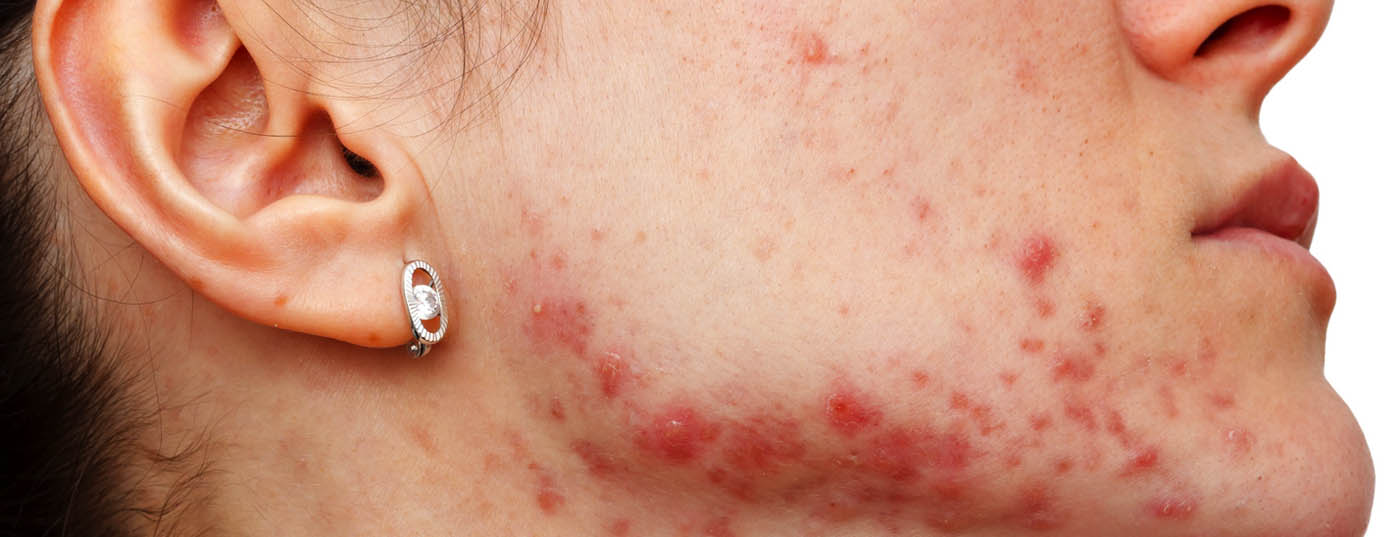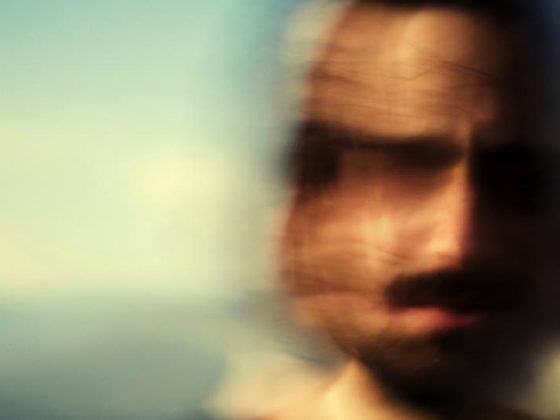Although a good repertoire of local and systemic acne therapeutics is available, patients are increasingly expressing a desire for non-drug treatment. Situations such as acne eruptions during pregnancy, desire for children, childbearing age, epilepsy, strong sun exposure and the like limit the choice. In the following, the locally effective treatment system AclearaTM with few side effects is presented.
Up to 70-95% of all individuals in young adulthood suffer from acne in varying degrees of intensity. Many of them – often women – do not get rid of the annoying pimples even up to the age of 40 and beyond [1]. Acne places a heavy burden on sufferers and generates high costs, as alleviation of symptoms is sought at all costs. There is no ethnic predisposition, but the severity is usually higher in male patients because testosterone is one of the precipitating factors [2].
When the hormones go crazy
The causes of acne are not fully understood and should not be the subject of this article. Hormonal changes, such as those that occur during puberty or pregnancy, are often at the beginning of an illness. This is because the formation of sebum is hormonally controlled: the sebaceous glands, which ensure that the skin and hair remain supple by producing the oily secretion, are stimulated by the sex hormones to increase production (seborrhea). Androgens not only stimulate sebaceous gland hyperplasia, but also promote the formation of proliferative hyperkeratosis in the excretory duct of affected follicles. Comedones develop. The formation of comedones can also be promoted by so-called comedogenic substances in cosmetics.
Propionibacterium acnes plays an important role in the resulting inflammatory process. Antibiotic resistance as a limiting factor should be mentioned in this context [3]. Smoking and stress also have a negative influence.
Acne can be treated effectively for a long time, permanent scars can be avoided. The forms of treatment for acne are as varied as its clinical manifestations. The EU Guideline Group recently published a simplified classification [4]:
- Comedone acne
- Mild to moderate acne papulopustulosa
- Severe acne papulopustulosa to moderate nodular acne
- Severe nodular acne and acne conglobata.
Drug therapy
Local treatments usually require four to six weeks before the first results are visible. The duration of treatment is usually several months. The recommendations of the EU Guideline Group are presented in abbreviated form in Table 1. The mode of action of the substances in detail will not be discussed further.
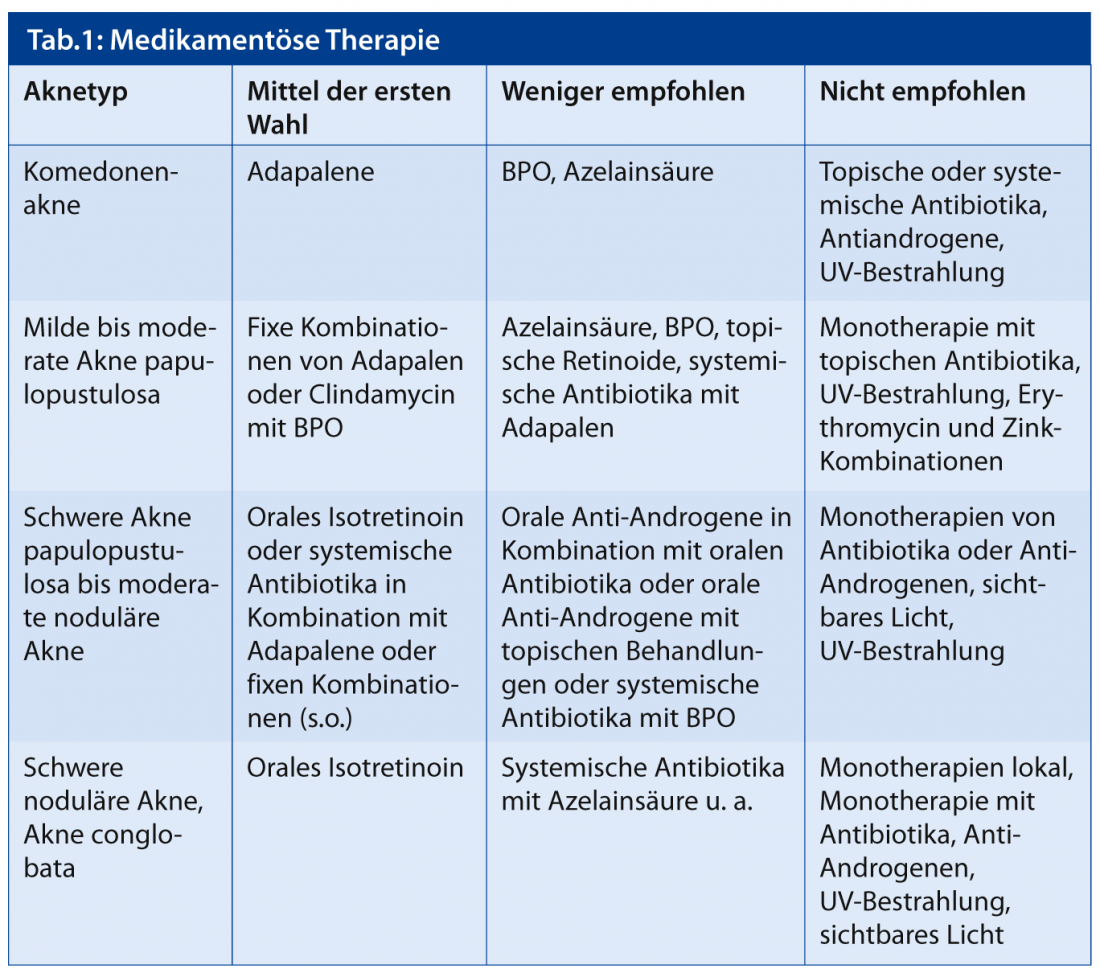
New forms of therapy with light and vacuum technology
Acne patients are not always able or willing to treat their skin disease with medication. Pregnancy, childbearing age, exposure to light, intolerances, mental illness, very dry skin, or the like may limit treatment options.
The AclearaTM Acne Treatment System (Fig. 1) extends and complements the existing range of therapies. It is the first FDA-approved continuous cooling system for the treatment of mild to moderate acne papulopustulosa and comedone acne. It can be used on all skin types. The device makes use of combined vacuum and broadband light filter technology, and the application is quick and easy.

The successful use of light technology (IPL, infrared and blue light) for acne therapy – both alone and in combination with other methods – has been reported on several occasions [5–9]. Shamban et al. treated patients with mild to severe acne with combined light and vacuum technology. In 50% of the treated patients, a significant improvement of acne occurred after only one application, and in 90% after four applications [10]. Gold et al. administered four treatments to their patients at three-week intervals and achieved significant treatment success [11]. Wanitphakdeedcha et al. treated 20 patients suffering from mild to severe acne with the combined light and vacuum procedure. They concluded that the greatest improvement had occurred in patients with the severe acne [12].
Functionality
After positioning the treatment head on the skin area to be treated (Fig. 2) the vacuum created cleans the pores by extracting the accumulated sebaceous gland secretion (Fig. 3). The device can create a vacuum of up to 0.2 bar in the respective treatment area, which leads to the lifting of the dermal structure towards the epidermis, whereby the accumulated sebum together with the bacteria present in it is emptied to the skin surface. Mechanical extraction of bacteria is of great advantage, especially when resistance develops [13].
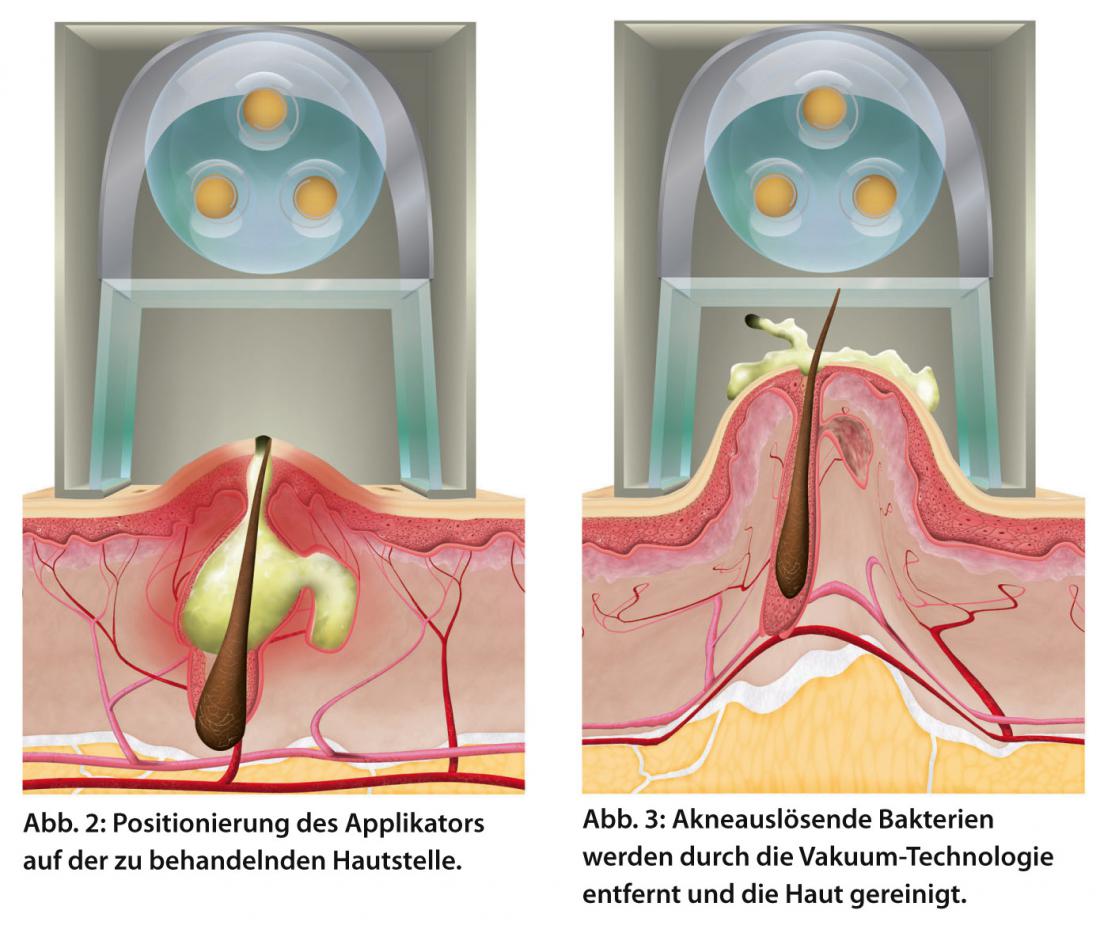
Together with targeted heating of the sebaceous glands, the broadband light with a cut-off filter of 500-1200 nm activates endogenous porphyrins to destroy propioni acne bacteria and reduces sebum production by photodynamic action (Fig. 4). The filter removes the shorter wavelengths, making the system safe for darker skin types. All skin types (I-VI) can be treated. Once the treatment is completed, the pores are left cleaned (Fig. 5).

The application is easy to learn and quick to perform (“Full Face” about 15 minutes). Nevertheless, the treatment technique requires some practice and experience in dosing the vacuum. Especially frontally and when taking anticoagulants, harmless but conspicuous rectangular hematomas can easily occur. Burns could also occur if the skin type is grossly misjudged.
User studies confirm effectiveness
Rho et al. investigated the clinical efficacy and safety of the new technology in their study [14]. There were 104 Korean acne and rosacea patients who participated in the study. Without the addition of drugs or further therapies, they received three treatments, each two weeks apart. These were performed without anesthesia and were judged to be well tolerated by the study participants.
All patients experienced erythema immediately after treatment, which disappeared spontaneously within one hour. Mild purpura occurred in 23 cases, mainly on the forehead, but resolved spontaneously after an average of four days. Evaluated on a scale of 0 (no improvement) to 4 (highly significant improvement), an average improvement of 2.3 points occurred after the first treatment, 2.9 after the second treatment, and 3.1 after the third treatment. A comparison of the individual lesion types showed that comedonal acne and acne papulopustulosa responded better to treatment than nodular and papular acne. Erythematous macules after acne showed significant improvement after the second and third treatments (2.7 and 2.9 points). Inflammatory rosacea lesions also showed good clinical improvement after the whole treatment series (2.7, 3.3, and 3.3 points). No adverse events were observed throughout the study period. In summary, Rho et al. concluded that the new technology provides effective and safe treatment of various types of acne and rosacea in Asian patients.
For his study, Vasily treated 17 patients between the ages of 15 and 46 (skin type I-III) with vacuum and broadband light [15]. All study participants had suffered from persistent facial acne for several years, with no satisfactory results achieved with topical and/or oral medication. Treatment generally produced significant improvement in symptoms, with five of the 17 patients experiencing significant flare-ups of acne as seen with vitamin A acid. In summary, Vasily considers two to four treatments at two-week intervals to be the most useful form of treatment. Most study participants required one or more additional treatments within three months.
Improved skin appearance in all treated patients
In a separate user study with 27 patients, the AclearaTM Acne Treatment System was used to treat all acne types. Since the treatment is chargeable and not covered by health insurance, only a small proportion – the 27 study participants – of all acne patients treated in the practice, mostly with a protracted course, opted for this sole or complementary treatment option. A selection of these patients and their treatment protocols are presented below:
Patient A received four treatments at one-week intervals (Figs. 6, 7). Three passes were performed in each case, the first two with energy level 5 and vacuum level 2, the third with energy level 4 and vacuum level 1. The short pulse shape with double pulse setting and pulse pauses of 750 ms were applied. Both the large and the small applicator were used.

Patient B was treated five times at intervals of one week each (Figs. 8, 9) . The three passes were performed with energy level 3 and vacuum level 2. Short pulse shape and double pulse setting were selected for pulse pauses of 750 ms. Both applicators (large and small) were used.
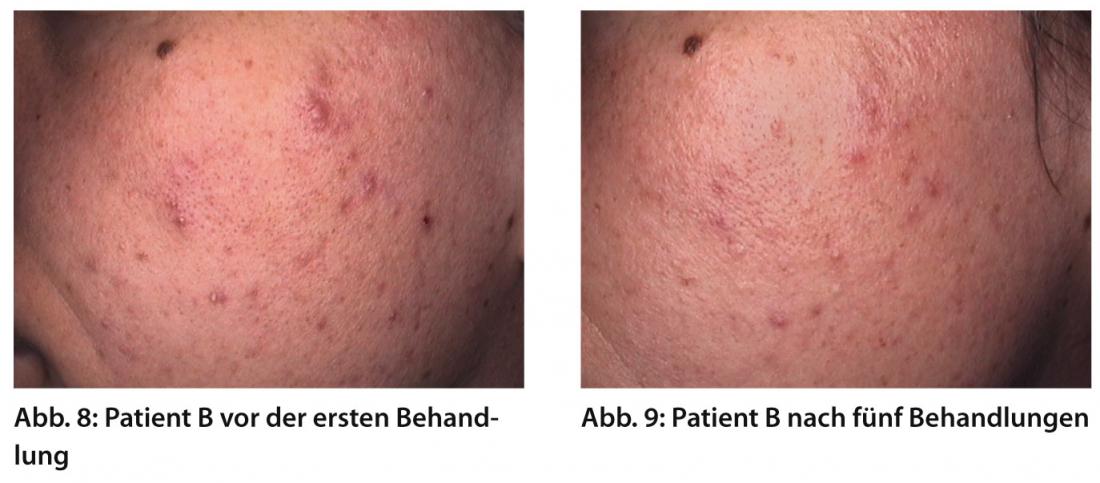
Patient C was treated three times within two weeks in a first cycle (Figs. 10, 11). After a three-week break, another cycle with four treatments at two-week intervals followed. With the exception of the last treatment, the large applicator was used, with different energy levels (3-6) and vacuum levels (1-3). Short pulse shape, double pulse setting and pulse pauses of 750 ms were other parameters.
Patient D received five treatments at different intervals between one and 2.5 weeks (Figs. 12, 13). Both applicators (large and small) were used, with energy level 5 or 6 and vacuum level 2 or 3. The short pulse shape with double pulse setting and pulse pauses of 750 ms were selected.
Patient E received ten treatments at intervals of one to two weeks (Figs. 14, 15). The three passes were performed with different energy levels (4-7) and vacuum levels (1-3). Both applicators were used with short pulse shape, double pulse setting, and pulse pauses of 750 ms.
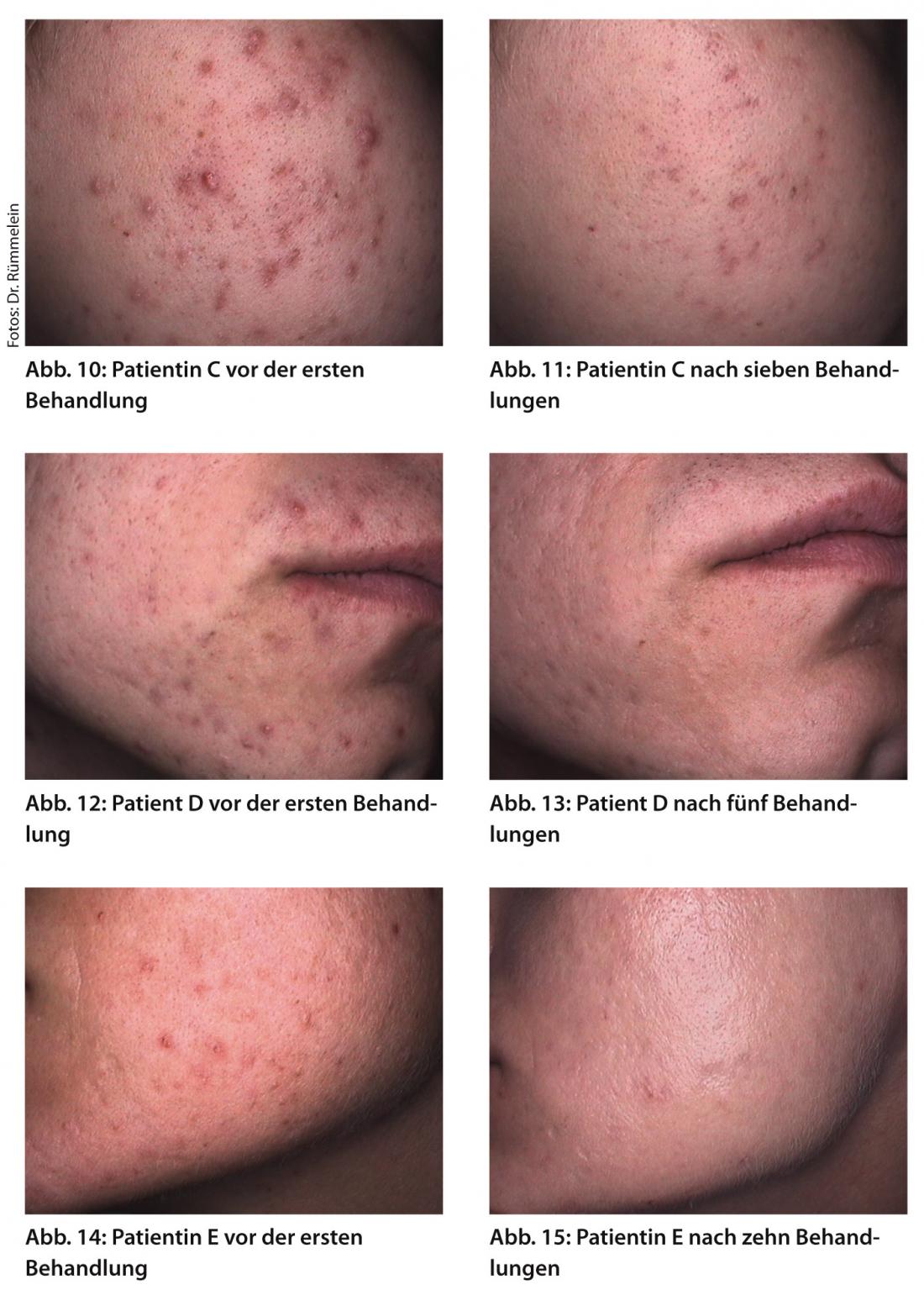
Of the 27 patients, 23 appeared on the recommended treatment regimen and received at least four, ideally six, treatments. After the fourth and, if necessary, after the sixth treatment, the treatment progress was photo-documented. Four patients discontinued therapy after one or two treatments, exclusively for pecuniary reasons. Three other patients were satisfied with the results of the treatment after only four applications, while two could not spare the time for further appointments.
Overall, all 23 study participants showed a pleasing result with reduction of pustules, papules and decrease of inflammation. Therapy was given as monotherapy in 15 patients, and eight patients received additional local therapeutics. However, they had already used these topical therapeutics before starting treatment with only moderate improvement in acne. 17 patients opted for intermittent continuation of Acleara treatment to maintain treatment success.
Conclusion
The new technology represents a meaningful expansion of the acne treatment spectrum that is highly appreciated by patients. It can be easily incorporated into the daily routine of a practice because it can be performed quickly. The actual treatment time for an entire face is 15 minutes, and the total room occupancy should be calculated at 30 minutes. The application is hygienic and largely pleasant due to disposable treatment heads. It does not require anesthetics or specific follow-up treatments. Treatments can be used as monotherapy or to complement and support traditional therapies.
Literature list at the publisher
Bettina Rümmelein, M.D.


